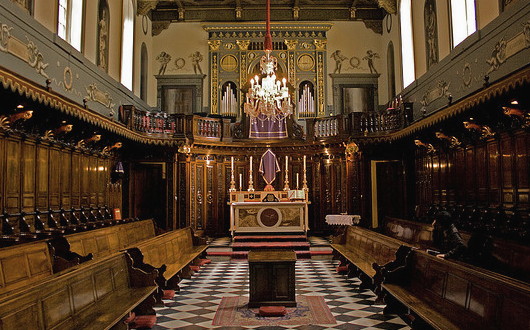Church
About Andrew Cusack
 Writer, web designer, etc.; born in New York; educated in Argentina, Scotland, and South Africa; now based in London.
Writer, web designer, etc.; born in New York; educated in Argentina, Scotland, and South Africa; now based in London. read more
News
Blogs
Reviews & Periodicals
Arts & Design
World
France
Mitteleuropa
Knickerbockers
Argentina
The Levant
Africa
Cape of Good Hope
Netherlands
Scandinavia
Québec
India
Muscovy
Germany
Academica
Vigil of Prayer at the Oratory
until
Friday 1 March 7am
There will be an Adoration Vigil (Exposition of the Blessed Sacrament) in the Little Oratory praying for the Church as we end the pontificate of Pope Benedict XVI, thanking God for all the graces during this pontificate and asking the guidance of the Holy Spirit for the cardinals as they meet to elect the new Pope.
The Vigil will begin Thursday 28 February at 9.30 in the evening and conclude with Mass at 7am the following morning.
Brompton Oratory
Brompton Road
London
SW7 2RP
Don Bosco in London
Just went to venerate the relics of Don Bosco, which are doing a UK-wide tour organised by the Salesian order. There was quite a crowd waiting for the Saint’s earthly remains to be unveiled at 2 o’clock — suprising for early afternoon on a workday. Before the relics were even made viewable there were pilgrims huddled around the veiled reliquary, whom the organisers eventually had to shoo away in order to organise some proper veneration.
The faithful are able to venerate the relics at Westminster Cathedral from 2:00pm to 8:30pm today and tomorrow only, after which they will spend the next two days at St. George’s Cathedral in Southwark before returning to Italy.
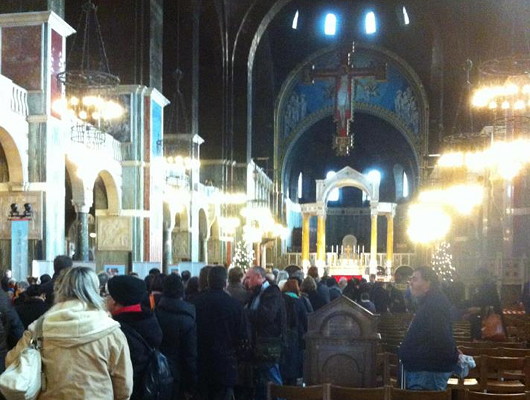
Tradtastic Hertfordshire
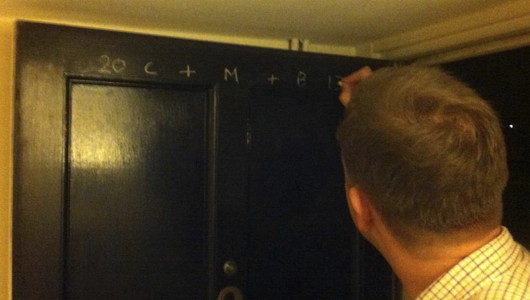
The bishops of England & Wales cunningly arranged for the Feast of the Epiphany to fall on the actual Epiphany this year. We had a great big festive lunch at our favourite little Italian place in South Ken, but the night before I went out to Hertfordshire, where I witnessed the tradition of a door being CMB’d with holy chalk for the new year (above).
Those unaware of this tradition can read a bit more here. The C+M+B stands both for Christus mansionem benedicat (“Christ bless this house”) and the names of the Three Magi: Caspar, Melchior, and Balthasar.
Return to Downside
Christmas was marked by a return to the Abbey Basilica of Saint Gregory the Great at Downside for Midnight Mass. The abbey church always has a splendid feeling at night. One of the best points at the wedding of the century was in the evening when, after a fair bit of dining and drinking, a whole slew of guests slipped into the church where the monks who a few hours previous had sung the nuptial mass were singing compline and joined in their prayers.
Doubtless you will recall last year’s Christmas diary documenting my holiday with Garabanda, Ming, und Familie. In the time since then, my own parents have very wisely moved onto the same landmass as I, and — even better — moved to nary a half-hour’s drive from Downside, so this Christmas was spent in blessed Georgian comfort with my own parents and all the delights of that particular patch of the West Country. (more…)
The Lady in Red
Or: Where to sit in church on Sunday
IT IS A LOGICAL TRUISM that good habits are good. But good habits — well and fine as they are — can also produce ancillary habits that, while not ‘bad’, might perhaps also be worth denying the dignified title of ‘good’; they are ammoral rather than immoral. Hearing mass on Sunday is a good habit — indeed it is an obligatory good habit binding upon all the Faithful. Some people express their habit of Sunday mass at varying locations — an attitude which I find surprising, which itself is surprising given until very recently I varied my Sunday mass locale myself.
In New York, it was easy: there was only one real place to hear Mass and that was the Church of St Agnes on 43rd Street. Of course, some dangerous rapscallions dissented from this point de vue and attend the Church of Our Saviour on Park Avenue. I remember one Sunday on Lexington Avenue seeing the group of lads who serve the 11 o’clock mass at St Agnes come down the avenue while the like gang who did the same at the Church of Our Saviour were coming up it on the same side and it was like seeing the Sharks and the Jets meet in “West Side Story”.
In London, I used to go here and there; mostly dividing my Sundays between the Oratory and the Cathedral but every now and then sneaking in Holy Redeemer in Chelsea. But for a year or so, I have been an Oratory regular, and now look strangely upon those who, when the insouciant inquiry at a dinner party or over drinks or such is made “Where do you go to Mass?”, reply “Oh, you know, sometimes here, sometimes there, sometimes I even go to the local parish.” (I never believe the last assertation; I, for one, have only been to my local parish twice: once this past St Patrick’s Day to pray, in vain, for an Irish victory at Twickenham, and lastly on one of those lesser-remembered Holy Days of Obligation.)
But the ancillary (ammoral) habit to the (moral) habit of hearing mass on a Sunday is the custom of sitting in the same place. If one is new to a particular church, one can sit here and there for quite some time, but eventually you find a bit of the church and you realise one Sunday “Ah! This is just right!” and from that day forth you have “your” seat. The chaps who do the collection obviously must have their proper places. The one-legged lady in the wheelchair who shouts at people has her usual spot. A certain sturdy Knight of Malta enjoys sitting in more or less the same location every Sunday, and one friend of mine inexplicably likes sitting in the middle of the row towards the middle of the first section of seats beneath the dome. Inexplicable to me because I cannot abide having to climb over people to get to and fro at mass.
Anyhow, needless to say, I have my preferred seat at the Oratory on a Sunday. It is not even a neighbourhood of seats, or a small vicinity, it is a specific seat and I am loathe not to have it. This is because it is at the confluence of the various important factors. It is not so close to the front that you are mistaken for the religious fanatic, the overly pious, or Princess Michael of Kent. Yet it is not so far to the back that you have to walk a mile to receive Our Lord in the Most Holy Sacrament of the Altar come communion time. (And have you ever sat towards the back at the Oratory? Barely anyone says the responses! The Fathers should set up a specific mission towards the last twenty-odd pews at the 11:00 on a Sunday — I suspect they are unbaptised the lot of them).
Furthermore, there is a duality to the mode of seating at the Oratory: the first two sections, comprising about the first third of the church, are actual seats, whereas the last section is composed of hard, uncomfortable wooden pews. (Perhaps they don’t say the responses because they’re embittered by discomfort?). Also, I dislike being in between the pulpit and the sanctuary, thus necessitating that you have your back turned to the priest when time comes for him to preach. And I prefer to nip up to communion rather swiftly, so I can return and get all my prayers in and not spend half the time standing in a queue awkwardly awaiting the reception of the Eucharist. This, therefore, necessitates that I be directly on the aisle.
“My” seat — I will not reveal its specific location within the Oratory Church of the Immaculate Heart of Mary, Brompton, for the obvious reason of inviting competitors — “My” seat is thus located in precisely the perfect location. Needless to say, I’m used to the others who have found that “their” seat is adjacent or nearby (though I’m glad that one chap who objects to dogs being at mass has given up and gone elsewhere). I feel we all implictly know and understand each other without actually intercommunicating, in that way that researchers who frequent the same stacks in university libraries feel a certain affinity.
About a month ago, we received a new regular to our midst: a white-haired lady in what might be described as late middle age, hebdomidally clothed in a red overcoat. She began to take the seat next to mine. Very well. Pas de problème, etc. Then one Sunday, a slow-moving Italian family attending the previous mass were lingering in “our” row and both she and I assumed positions ready to take possession of our regular seats. Imagine my surprise, then, when the Lady in Red, in full knowledge of my presence, took my seat! Friends were in from the country that week and said they watched the entire scene in detached amusement from the other side of the church. Needless to say, I was reduced to taking the next seat over, usually the Lady in Red’s seat.
What did this fresh assault upon my dignity betoken? I knew not. But I was determined that, in the immortal words of an American president, this aggression would not stand. The next Sunday I made sure to arrive extra early and secure my seat succesfully but untriumphantly. (Triumphalism is a tiresome bore in others and a poor reflection upon one’s self). The Sunday following that she appeared in pole position to usurp my place yet again, but then she didn’t: she let me have it. This, of course, was really a back-handed triumphalism. Haha! See! I shall be the better Christian and let you have the seat to which you have been accustomed since time immemorial! Look ye mighty upon my works and despair!
“Very well!,” I thought, “two can play at this game!” I was determined the Sunday following to arrive early and to deferentially allow her to have the place to which I had grown to know and love so well. But, friends, the best-laid schemes of mice and men gang aft agley. This past Sunday I arrived a mere minute or two before mass was to start, and thus I was forced to sit in the north transept instead. What’s worse, the Lady in Red wasn’t even sitting in my seat: she had ceded it to a mantilla’d Filipino lady.
This raises a fresh quandary. If this past Sunday was “my” week to defer to her, but I failed, and she deferred to someone else, does that then mean that I must defer next week, and the rotation begins anew? Or do we stick to the previous rotation of her week / my week? I know not, but I must be off now, as my French flatmates are wailing, and I suspect there may be a mouse for me to kill. Abientot!
Fr Kramer on Tradition
Readers might enjoy this video from CNS featuring Fr Joseph Kramer, one of the FSSP’s priests in Rome. I met Fr Kramer very briefly on the street when I was in Rome in 2006. It might be time for another visit to the Eternal City.
The Hon. Lady Goulding
Grande dame of charity and sometime Fianna Fáil senator who provided a ‘harbour of hope’ for the disabled & represented Ireland in squash
IF, LIKE ME, YOUR Venn diagram shows a massive overlap for the circles representing politics, history, aesthetics, and design, then the Irish Election Literature website is a dangerous place where you can waste many minutes of your day. Not long ago, I stumbled across their collection of electoral bits related to Valerie, the Hon. Lady Goulding — at least I think that’s the proper style, these realms are arcane and murky. She was most often, but incorrectly referred to as Lady Valerie Goulding, the fate of many wives of baronets I’m afraid.
She was born Valerie Hamilton Monckton in 1918 at Ightham Mote (pronounced “item moat”, obv.), the house noted for its Grade I listed dog kennel. Her father, Sir Walter Monckton (later 1st Viscount Monckton of Brenchley) was a trusted friend of Edward VIII, and the teenage Valerie was employed as a messenger shuttling letters between the King’s refuge at Fort Belvedere and Stanley Baldwin in Downing Street. Visiting Fort Belvedere in 1993, Lady Goulding recalled the last lunch she had attended there in December 1936:
She [Mrs Simpson] was leaving that afternoon for Cannes, and everyone was talking about nothing so as to avoid what was on everyone’s mind. But one really nice thing happened: there were four bottles of beer next to my place. The King had remembered that when we were rounding up the ponies on Dartmoor the previous year I had a beer in the pub, and that he had remarked that I was very young to be drinking. It was very touching.
In 1939 she attended the Fairyhouse races and met Sir Basil Goulding at a dinner party. Goulding had significant business interests in Ireland and became known for once entering a bank board meeting on rollerskates. On her second visit to Ireland, they became engaged, and married quickly as the threat of war loomed on the horizon. Sir Basil served in the RAF, rising to the rank of Wing Commander, while Lady Goulding opted for the First Aid Nursing Yeomanry before switching to the Auxiliary Territorial Service. After the war, the Gouldings moved to Dargle Cottage in Enniskerry, Co. Wicklow. (more…)
Cardinal Manning
Over at Reluctant Sinner, Dylan Parry has an excellent post on Cardinal Manning, the second man to serve as Archbishop of Westminster. Manning is all too often forgotten, despite being one of the most widely loved and respected men of his generation. His funeral, famously, was the largest ever known in the Victorian era. Besides his wisdom at the helm of England’s most prominent see, the good cardinal’s greatest legacy might be his influence on Rerum Novarum, the great social encyclical of Leo XIII. Dylan is planning on writing further on the subject of Cardinal Manning, giving us something to look forward to. (more…)
The 8th Earl of Wicklow
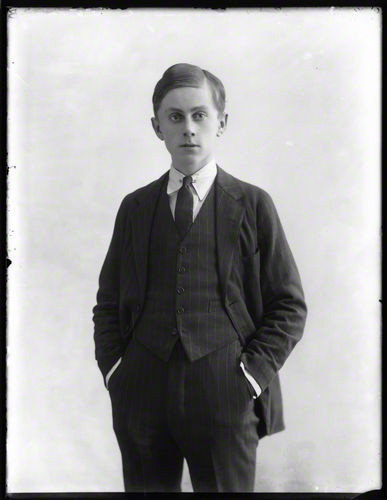
William Cecil James Philip John Paul Howard, 8th Earl of Wicklow (styled Viscount Clonmore from his birth until succeeding to the earldom in 1946) was received into the Church at the age of thirty in 1932. Having attended Mass with the family’s Catholic servants, he was banished from visiting the family home on Sundays in addition to being disinherited. He later married the architect Eleanor Butler who served in Seanad Éireann from 1948-1951. Above is one of three photographs of Viscount Clonmore in the collection of the National Portrait Gallery.
Mullen, the Times, and Christianity in China
The Rev’d Peter Mullen on top form:
[T]here has been a great deal of press conjecture about the reasons behind the rapid growth of Christianity in China – one item in particular in that frivolous girls’ magazine called The Times. Could it be, as the airhead bimbo who wrote the piece opined, a result of the progress of capitalism in China? Or might it have something to do with the Hegelian dialectic? You could be tempted by her baroque phraseology to take her half-seriously: until you realise with a shudder that this is the same Madchen who writes The Times‘ regular columns on knicker elastic and of who’s going up and down in the celebrity ratings.
Perhaps – I don’t know, but perhaps – the rapid rise of Christianity in China has something to do with its appeal to hearts and minds: to the intuition that this thing called the Christian faith has the ring of truth about it? It doesn’t sound, on the face of it, to be an implausible thought with which to start.
Valle Adurni on Catholic France
The blogger ‘Pastor in Valle’, who writes over at his blog Valle Adurni, recently composed a splendid overview of Catholic France basically from the baptism of Clovis onwards. Of course, it’s a very general overview, but Pastor has rather skillfully managed to manage to pack a lot into relatively few words.
It’s in five sections: here are the first, second, third, fourth, and fifth.
Catholic Ambassadors to the U.N.
Diplomats’ group hears Latin Mass at St Agnes
On Sunday 21 August 2011, the Church of St Agnes on 43rd Street in Manhattan was host to a group of Catholic ambassadors to the United Nations for the regular 11:00 Extraordinary Form Mass, offered by Fr. Richard Trezza OFM. (Fr. Cid, a recently ordained Franciscan priest was also in choro). The group included representatives from Grenada, Haiti, the Philippines, Korea, the United Kingdom, and Japan.
The informal gathering, formed just this year, is open to Catholic Permanent Representatives and Deputy Permanent Representatives — the first- and second-highest ranking diplomats at national missions to the U.N. — and has heard Mass at a number of different parishes around Manhattan. (more…)
Vatican Insider
Anyone remotely interested in the important affairs of the church and the world should make themselves aware of the new ecclesial news site, Vatican Insider. The site offers English translations of the significant journalistic output of the Italian newspaper La Stampa and includes commentary from Andrea Tornielli, John Allen, and others. V.I. already has an interview with Mons Georg Ratzinger and a look at church-state relations in mainland China, amongst other things. Definitely one to add to your daily perusing.
Fra Freddy, Rest In Peace
Yesterday, I was very saddened to hear of Fra Freddy’s death. Fra Freddy was a legendary character whom I was introduced to in my first year at St Andrews. He was invited to speak to the Catholic students most years on some subject or another — an introduction to prayer or a lenten meditation. I was quite pleased when he was so taken with a poster I designed to advertise one of his talks that on his way back to Edinburgh he nipped out of the car at the last minute and grabbed a large copy. Fra Freddy was an old-fashioned stick-in-the-mud with a good sense of humour, but he also had the capability to surprise with a kind word when you least expected it.
Fra Fredrik John Patrick Crichton-Stuart was born September 6, 1940 to Lord Rhidian Crichton-Stuart (son of the 4th Marquess of Bute) and his wife Selina van Wijk (daughter of the Ambassador of the Queen of the Netherlands to the French Republic). He was raised in Scotland and North Africa (where his father was British Delegate to the International Legislative Assembly of Tangier) and was educated first at Carlekemp in North Berwick and then at Ampleforth. He joined the Order of Malta in 1962, later being named the Delegate for Scotland & the Northern Marches. In 1993 he was appointed Chancellor of the resurrected Grand Priory of England. Fra Freddy became Grand Prior himself when his cousin, Fra Andrew Bertie, died in 2008 and was succeeded by the then-Grand Prior of England, Fra Matthew Festing.
Fra Freddy was a devoted follower and promoter of the traditional form of the Roman rite. He joined Una Voce Scotland in 1996 and became secretary in 2000. Two years later he was named councillor and senior vice-president of FIUV, the International Federation ‘Una Voce’, and briefly served as its president in 2005.
Over the past year or so Fra Freddy had been varying ill but seemed to recover. I am told he was found dead yesterday morning, still clasping his breviary. He was well-known in Edinburgh and beyond, and he will be missed by his many friends as well as those who worked and volunteered with him or interacted with him in his charitable activities.

FREDERICK JOHN PATRICK CRICHTON-STUART
Grand Prior of England
of the
Sovereign Military & Hospitaller Order of St John
of Jerusalem of Rhodes and of Malta
6 September 1940 – 14 June 2011
Eternal rest grant unto him, O Lord,
and let perpetual light shine upon him.
May he rest in peace.
Amen.
Prayer to St. Joseph for Priests
Where would we be without priests? Terrible to even consider. Ever since the Year for Priests held in 2009-2010, I have tried to remember priests in my intentions much more frequently than before, especially those brilliant priests who’ve had an influence in my life in Scotland, South Africa, New York, and elsewhere.
Fr Mark over at Vultus Christi posted this prayer to Saint Joseph for priests a few weeks back, and it seems worth reblogging.
O glorious Saint Joseph,
who, on the word of the angel
speaking to you in the night,
put fear aside to take your Virgin Bride into your home,
show yourself today the advocate and protector of priests.
Protector of the Infant Christ,
defend them against every attack of the enemy,
preserve them from the dangers that surround them
on every side.
Remember Herod’s threats against the Child,
the anguish of the flight into Egypt by night,
and the hardships of your exile.
Stand by the accused;
stretch out your hand to those who have fallen;
comfort the fearful;
forsake not the weak;
and visit the lonely.
Let all priests know that in you
God has given them a model
of faith in the night, obedience in adversity,
chastity in tenderness, and hope in uncertainty.
You are the terror of demons
and the healer of those wounded in spiritual combat.
Come to the defence of every priest in need;
overcome evil with good.
Where there are curses, put blessings,
where harm has been done, do good.
Let there be joy for the priests of the Church,
and peace for all under your gracious protection.
Amen.
The Modern Baroque: Brasini in Parioli
The Church of the Immaculate Heart of Mary
GOOD ARCHITECTURE requires a combination of willpower, taste, and resources. This nexus used to occur quite often; instances from the Renaissance and the long nineteenth century come most easily to mind. A late twilight of this combination is found in the magnum opus of the Italian architect Armando Brasini: the Church of the Immaculate Heart of Mary in Rome’s swish Parioli neighbourhood.
The 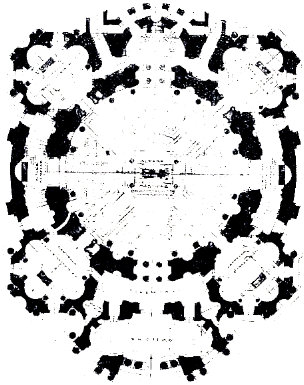 church, a modern expression of the Baroque, has somewhat curious and disjointed origins. Every age has left its imprint on Rome in one way or another: the Rome of the Republic, the Rome of the Empire, the Rome of the Popes, the Rome of the Liberals, the Rome of the Fascists, the Rome of the Italian Republic. In the 1900s, it was realised that the Church had not made a significant contribution to the great architecture of Rome for some time. Worse: the more significant structures of the past century were mostly built by the government of the Sardinian kingdom that conquered Rome and gave itself the fanciful, if geographically correct, name of ‘Italy’. A new church was needed, on a monumental scale, to be the age’s contribution to the great churches of Rome. Originally, the church was to be dedicated to St. James the Greater, but as preparations increased for the International Marian Year of 1924, it was decided the cult of the Immaculate Heart of Mary would take precedence instead. (more…)
church, a modern expression of the Baroque, has somewhat curious and disjointed origins. Every age has left its imprint on Rome in one way or another: the Rome of the Republic, the Rome of the Empire, the Rome of the Popes, the Rome of the Liberals, the Rome of the Fascists, the Rome of the Italian Republic. In the 1900s, it was realised that the Church had not made a significant contribution to the great architecture of Rome for some time. Worse: the more significant structures of the past century were mostly built by the government of the Sardinian kingdom that conquered Rome and gave itself the fanciful, if geographically correct, name of ‘Italy’. A new church was needed, on a monumental scale, to be the age’s contribution to the great churches of Rome. Originally, the church was to be dedicated to St. James the Greater, but as preparations increased for the International Marian Year of 1924, it was decided the cult of the Immaculate Heart of Mary would take precedence instead. (more…)
John Rao on PBS
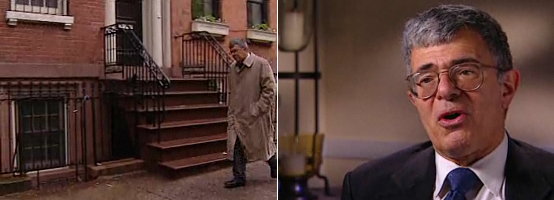
The other day I stumbled upon this blog post from the Chairman of the LMS which included a segment from Religion & Ethics Newsweekly, the hebdomodal programme shown on PBS in the States. The R&E spoke with Dr. John Rao, associate professor of history at St. John’s University in New York and director of the Roman Forum, about the annual Paris-Chartres pilgrimage which unites tradition-minded Catholics from across the globe every Pentecost. You can watch the segment or read the transcript here on the PBS website. It’s also available on gloria.tv here.
I’ve already commended any New York readers of andrewcusack.com to attend the series of historical lectures in Greenwich Village organised by the Roman Forum. It’s time already to consider the annual summer symposium in Gardone on Lake Garda in Italy. This isn’t a boring academic conference where stuffy professors will present papers, this is a symposium in the truest sense. The root of the Greek word means literally “to drink together”, and that more closely reflects the Gardone spirit: a jovial meeting of minds where matters high and low can be discussed in a convivial attitude surrounded by the beauty of the Italian lakes.
Everyone I know who’s attended the Gardone symposium has come back with rave reviews, and many add it to their annual calendar. I’m really, really hoping to make it there this year for the first time, and I hope others will give it a go as well. From June 30th through July 11th, 2011. Click here for more info.
A Pell Sighting
…and sundry other occurences
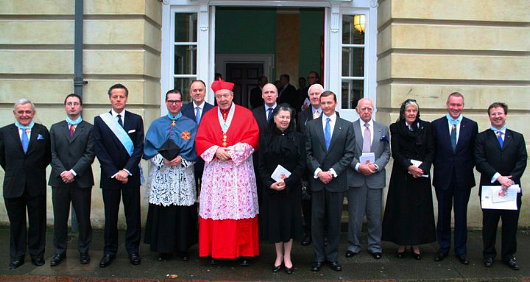
Outside of Rome, you don’t run into cardinals all that often, but last Saturday I caught sight of one of the most popular clerics in the Catholic Church: Australia’s Cardinal Pell. The occasion was the Cardinal’s reception into the Sacred Military Constantinian Order of St George, which took place in the Little Oratory. His Royal Highness the Duke of Noto presided over the investiture, and if you squint your eyes enough you can make out a profile shot of Young Cusack in the background of the photo of the Duke (below). In addition to the Cardinal Archbishop of Sydney’s being made a Bailiff Grand Cross of Justice, six others were invested as members of the Constantinian Order, including His Excellency Don Antonio da Silva Coelho, the Ambassador of the Order of Malta to the Republic of Peru. For more info, see the Order’s notice on the event. (more…)
Dempsey Heiner (1927–2008)
THIS MONTH IT’S already three years since the death of dear Dempsey Heiner, who went to his eternal reward on 16 January 2008. Demspey was a real gem of a man: a scholar and a gentleman, capable of relaying brilliant insights easily and who, at least once, exhibited his skill in the art of the gentlest intellectual rebuke of a presumptuous young intellectual fellow-Catholic (i.e.: yours truly), backed up with a remembered citation of François Mauriac.
Dennis Clinton Graham Heiner was born in New York in 1927 to Robert Graham Heiner and Frances Eliot Cassidy, friends and fellow-travellers of Margaret Sanger, the notorious racial eugenicist & founder of Planned Parenthood. Dempsey’s parents enrolled him at St. Bernard’s, where he was in the same year as George Plimpton, the founder of the Paris Review and twentieth-century embodiment of the gilded amateur. Plimpton (who died in 2003) described Dempsey as “the brightest boy in the class, a genius” and remarked that since leaving school he remained something of an enigma. (more…)
The Start of Something Big in Argentina
The first-ever Nuestra Señora de Cristiandad Pilgrimage to Luján
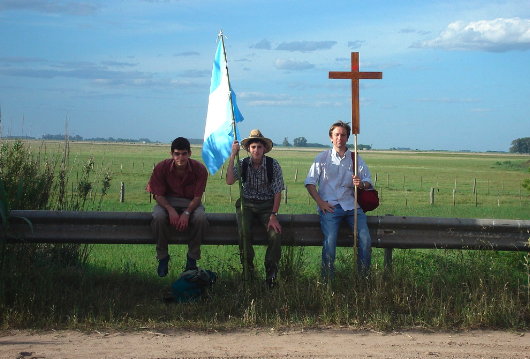
SMALL SEEDS, IF well-planted and tended to, flower into much larger growths. On a Friday morning last month, just four pilgrims set out from the town of Rawson in the Buenos Aires province of Argentina, but by the time they reached their destination — a Latin Mass in the Marian basilica of Luján — their numbers swelled to nearly a hundred. The pilgrimage of November 5th, 6th, and 7th, under the patronage of ‘Our Lady of Christendom’ (Nuestra Señora de Cristiandad) was inspired by the traditional Paris-Chartres pilgrimage every Pentecost weekend. The organisers hope that, like the Chartres pilgrimage, this trek to Luján will become an annual recurring event.
“Renewing Christendom in Argentina” was the theme of this year’s pilgrimage, which “seeks to promote the rich tradition of the Roman Catholic Church for our times” the organisers announced in a press release after its completion.
“This new 100-kilometre pilgrimage was an act of reparation and praise to God, imploring the salvation of souls through the renewal of Christian culture and the rediscovering of the bi-millennial tradition of the Church.” (more…)
Search
Instagram: @andcusack
Click here for my Instagram photos.Most Recent Posts
- Silver Jubilee November 21, 2024
- Articles of Note: 11 November 2024 November 11, 2024
- Why do you read? November 5, 2024
- India November 4, 2024
- The Lithe Efficiency of the Old Constitution November 4, 2024
Most Recent Comments
Book Wishlist
Monthly Archives
Categories

